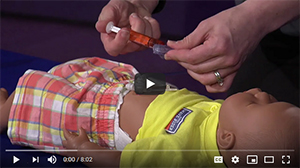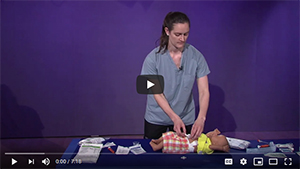Malecot/Foley
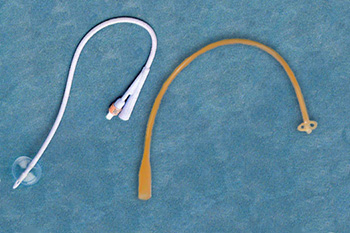 The Malecot Gastrostomy Tube is a gold colored tube held in place with a dissolvable stitch inside the stomach. This type of tube is only placed surgically. With this tube the stomach is stitched to the abdominal wall. There is also a stitch on the skin surface which will typically release from the skin about 10-14 days after the tube is surgically placed. However, the stitch generally remains wrapped around the tube. The Malecot is a tube that is placed surgically and should stay in for a minimum of 3 months prior to being removed to allow for proper healing and track formation of the stomach and the abdominal wall. Once it is removed, your child will most often have a button type tube (low-profile) tube placed.
The Malecot Gastrostomy Tube is a gold colored tube held in place with a dissolvable stitch inside the stomach. This type of tube is only placed surgically. With this tube the stomach is stitched to the abdominal wall. There is also a stitch on the skin surface which will typically release from the skin about 10-14 days after the tube is surgically placed. However, the stitch generally remains wrapped around the tube. The Malecot is a tube that is placed surgically and should stay in for a minimum of 3 months prior to being removed to allow for proper healing and track formation of the stomach and the abdominal wall. Once it is removed, your child will most often have a button type tube (low-profile) tube placed.
Using and Caring for Balloon Type Gastrostomy Tubes
Routine Care for the Malecot Gastrostomy Tube and Site
Cleaning the Site
- Wash your hands with soap and water before touching the G-tube site.
- Use warm soapy water on a Q-tip to clean around the G-tube once a day (more often if needed).
(May use ½ strength hydrogen peroxide instead if there is crusting around the tube that is difficult to remove with soap and water or if it is becoming reddened around the tube. If using ½ strength hydrogen peroxide be sure to rinse with plain water after cleansing.) - Pat dry
- After 2 weeks from original tube placement/surgery, may have regular baths (submerge in water)
- Do not use heavily scented soaps or cleansers.
- Do not apply ointments or medications to the area unless instructed by your healthcare provider.
Gauze Roll Dressing - Malecot (gold tube) or Foley catheter (blue replacement tube)
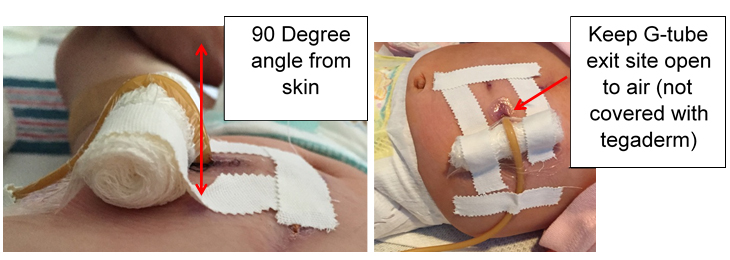
If possible, dressing change should be done with 2 people. If not, you can swaddle the baby with his/her arms tucked in the blanket.
- Make a gauze roll out of 2-3 packs of 2x2 sterile gauze and secure the roll with tape to prevent the roll from flattening over time
- Place the gauze roll directly at the G-tube entry site to avoid tension being placed on the tube. The tube should exit the skin at a 90 degree angle and then drape over the gauze roll (see picture below)
(Try to alternate placement of gauze roll from one side to another with each dressing change) - Preferable to use the (2 ½ x 2 ¾ inch) tegaderm and tape to secure
- Keep the G-tube site open to air (do not cover with the tegaderm)
- Change dressing every 2-3 days or as needed if soiled, wet, or falling off.
Important: Once the black suture that is wrapped around the gold tube is no longer attached to the skin, it is especially important to be gentle changing the dressing. Hold the tube steady to prevent it sliding in/out of the skin during dressing changes which could lead to skin breakdown and/or granulation tissue development, or accidental dislodgement.
Securing the Tube
Movement and pulling on the G-tube site should be minimized to prevent trauma and leakage.
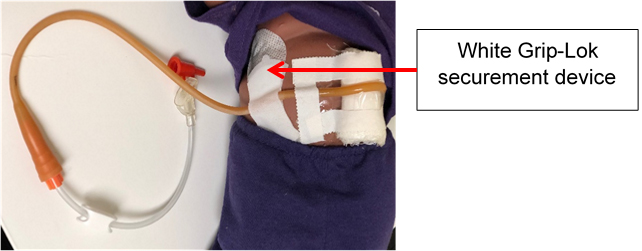 You should always use some sort of securement device, such as a Grip-Lok or Cinch, or medical tape, such as Micropore (paper tape) or Hypafix to secure the length of this tube because the end is heavy.
You should always use some sort of securement device, such as a Grip-Lok or Cinch, or medical tape, such as Micropore (paper tape) or Hypafix to secure the length of this tube because the end is heavy.- Onesies, one-piece sleepers, overalls, or other one-piece clothing will help keep the G-tube from being pulled out.
- Stretchy gauze/netting used to cover abdomen
- ACE bandage: May be used similar to an abdominal binder for younger children/infants. If using ACE wrap, cut it in half lengthwise and be sure not to pull it tightly around the abdomen or it will compress the G-tube into your child’s skin
- Abdominal binder: may be used for older children/adolescents
- Use a “tape tag” and safety pin to pin the tube to your child’s clothing to prevent accidental pulling at the G-tube site. (If using, be careful when undressing your child. You MUST remove the safety pin first!)
Bathing and Swimming
- May swim in a chlorinated pool 2 weeks after surgery as long as the exit site well healed
- May swim in a lake/ocean 2 months after surgery
Activity
- Your child may not participate in strenuous activities (contact sports, gym class, playground equipment, etc) for 1 month. After 1 month, your child may participate in strenuous activities if they keep the G-tube covered/secured (minimally for the first 3 months) to prevent dislodgement. After 3 months, your child should remain mindful of the G-tube, but an abdominal binder/cover is not required.
- Tummy time is okay for young infants. Your child may sleep or spend time on his/her belly. Make sure the G-tube is taped securely.
- If your child does physical therapy/occupational therapy, they may resume 2 weeks after surgery. Until then they may do exercises that do not place them on their belly or use core muscles.
Using the Malecot Gastrostomy (G-tube)
Flushing or giving Medications via Malecot tubes (gold colored tubes) or Foley catheter (blue replacement tube):
- Supplies needed: catheter tip syringe or oral syringe, water for flushing, medications in liquid form
- Fill syringe with water (amount to be determined by your health care provider)
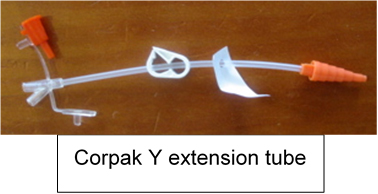 Put the syringe into one of the ports at the end of the Corpak Y extension tube, be sure the other port is capped/closed
Put the syringe into one of the ports at the end of the Corpak Y extension tube, be sure the other port is capped/closed- Unclamp the Corpak Y extension tube
- Slowly push the water into the tube
- If no issues flushing the tube may repeat process with the medications. Be sure to clamp/unclamp the extension tube between each medication and flushes
- Be sure to flush the G-tube with water after administering medications
- Cap the two ports of the extension tube and clamp it (white clamp) if not in use.
Feeding Through the G-Tube
- Supplies needed: Feeding pump, feeding pump tubing/bag, IV pole, formula at room temperature.
- Hang feeding bag on IV pole.
- Close clamp on G-tube extension set.
- Fill feeding bag with formula. (No more than 8 hours of formula at a time).
- Place tubing into the pump. Prime tubing (run the formula through the tubing) as instructed.
- Set the pump settings as instructed
- Connect pump tubing to one of the ports on the extension piece (the clear tube with the orange ends) not directly to the gold tube (Malecot)
- Start the pump, making sure to unclamp the extension piece
- Once the feeding is completed, flush the G-tube as instructed, cap the extension tube ports and rinse feeding bag and tubing with warm tap water.
- Discard or wash the feeding bag and tubing every 24h or as instructed.
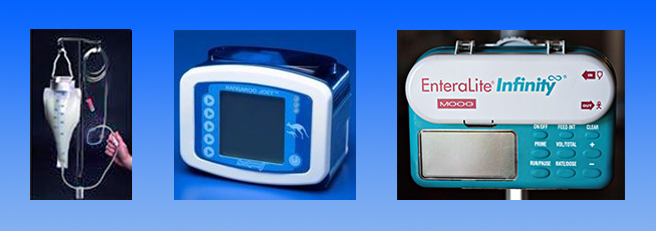
Venting the G-Tube
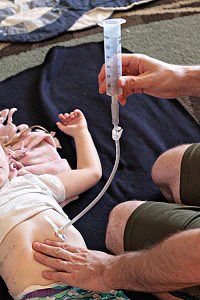 Venting is done to release air from the child’s stomach (when the child’s belly looks big/distended, the child seems uncomfortable, or the child needs to burp)
Venting is done to release air from the child’s stomach (when the child’s belly looks big/distended, the child seems uncomfortable, or the child needs to burp)- Place a 60mL catheter tip syringe without the plunger on the end of the G-tube. You will need to remove the extension tubing to do this as the catheter tip of the syringe will not fit on the end of the Corpak Y-extension piece
- Allow air to come out through the tube into the syringe (1 – 2 Minutes).
- If air does not come out… remove the syringe, place the plunger back into the syringe.
- Then place syringe with plunger into the G-tube.
- Gently pull back on the plunger to get the air out of the child’s stomach.
- Formula may come back into the syringe during venting, be sure to give any formula that backs up in the syringe back to the child taking care not to push in any air.
- When you are done, be sure to replace the extension tubing back on the end of the G-tube and cap both ports.
Cleaning the Equipment
- You may wash the extension tubing and the feed tubing only with warm soapy water or half white vinegar/half water solution, but do not wash the gold or blue G-tube.
- Instead, flush the G-tube through with warm water
- Rinse feeding bags after use
- Hang the feed tubing to dry or flush air through tubing if there is a lot of water
- Do not put tubing in the dishwasher
